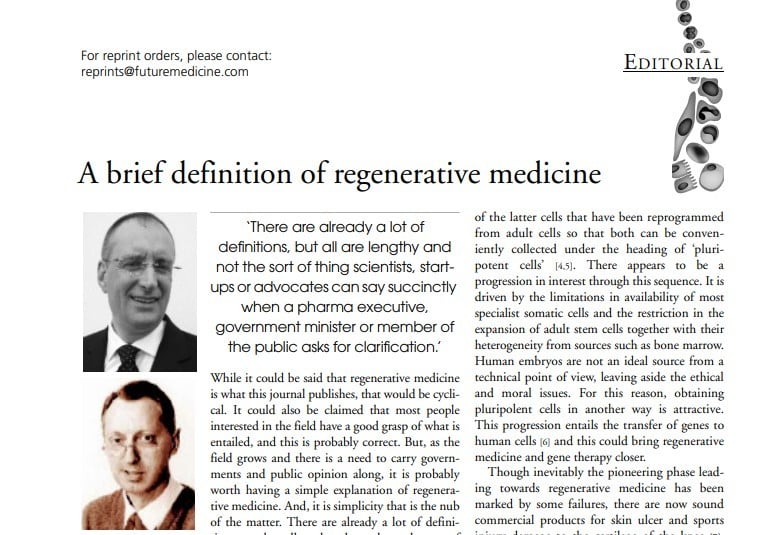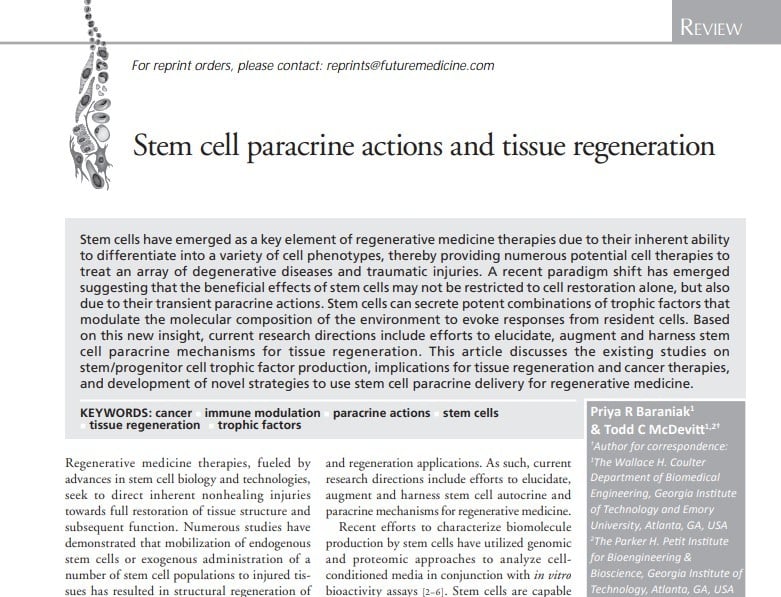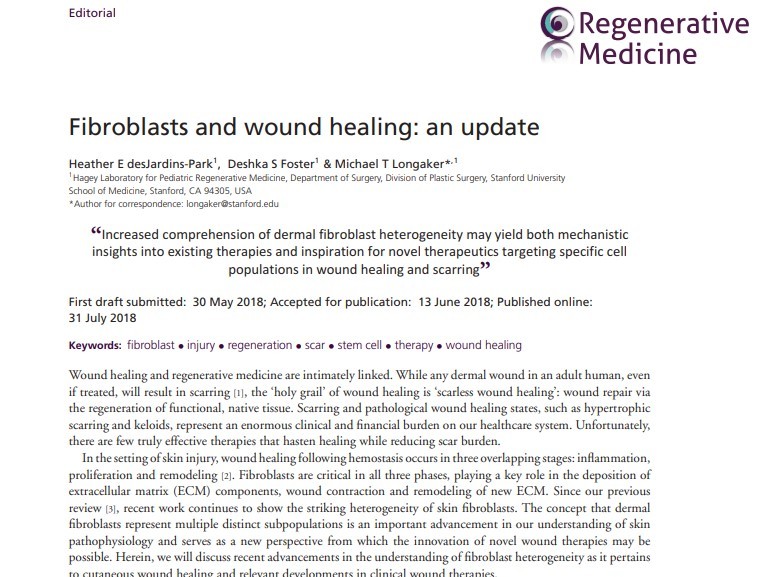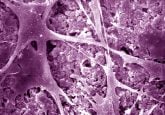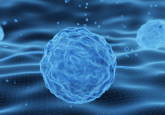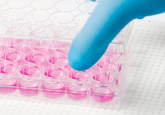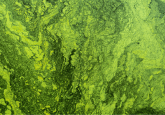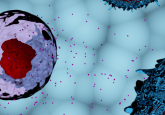A brief history of Regenerative Medicine: top 10 articles from 15 years of the journal
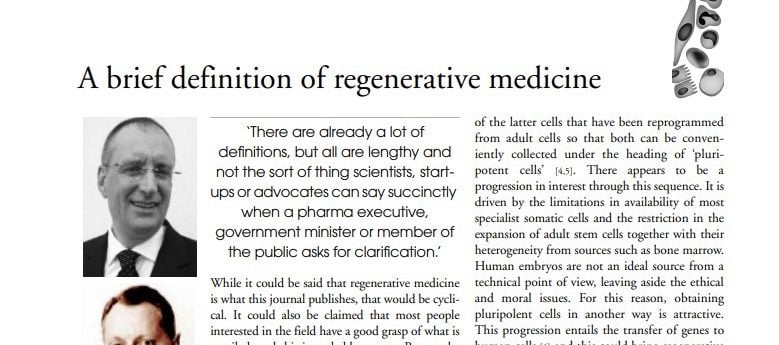
Since the birth of Regenerative Medicine in 2005, the field has moved forward in leaps and bounds. From the use of mesenchymal stem cells for the treatment of neurodegenerative disease, to a unified theory of aging, we look back at some of the most popular content from the last 15 years, in no particular order, and look forward to what the future has in store for our much-loved journal and the field as a whole.
2007: A brief definition of regenerative medicine
As the field of regenerative medicine continues to develop and stretch into the domain of government and public opinion, its defining terms become broader and more lengthy. In efforts to provide clarity on the subject, the authors of this article address the matter and the origins and relationships that help to define the field.
2009: Biomaterials for vascular tissue engineering
Various tissue engineering strategies have recently emerged to address the biological challenges at the blood–material interface when developing prosthetic vascular conduits for cardiovascular disease. These include vascular cell seeding of scaffolds and the design of bioactive polymers for in situ arterial regeneration, which have so far yielded positive results. This article describes the advances made in the design of biomaterials to generate appropriate materials, including synthetic nondegradable polymers, degradable scaffolds and biopolymers.
2006: Clinical applications of stem cell therapy – the pros and cons of stem cell sources
“The revolution of using stem cells for regenerative medicine has begun.” Certainly a momentous opening line for this article, published back in 2006, when the dream of using stem cells to repair tissues and create new organs was starting to become a reality. Stem cells can be obtained from a variety of sources, though some of them are more likely to find clinical application than others. This article explores the potential for different types of stem cells to be applied to regenerative medicine.
2015: The translation of cell-based therapies: clinical landscape and manufacturing challenges
The ever-increasing number of cell-based therapies in the development pipeline means this industry has the potential to provide significant health and wealth benefits throughout the world. With this increase in regenerative medicine innovation comes a need for a better definition of the manufacturing requirements for cell-based products. This study, published in 2015, assesses a total of 1342 cell-based clinical trials to provide an overview of the then state of cell therapy clinical development and identify gaps in their manufacturing requirements.
2009: Stem cell paracrine actions and tissue regeneration
Another noughties vintage, this review paper describes the potential beneficial effects of stem cells in light of their transient paracrine actions, with subsequent research directions including efforts to elucidate, augment and harness stem cell paracrine mechanisms for tissue regeneration. The authors conclude that learning to modulate and harness the paracrine actions of stem cell populations provides researchers with a myriad of treatment options for traumatic injury and diseases limited by cell sourcing issues. It’s certainly exciting to see how the field has advanced since.
2010: Shear stress induces osteogenic differentiation of human mesenchymal stem cells
Does fluid flow-induced shear stress affect the differentiation of bone marrow-derived human mesenchymal stem cells (hMSCs)? Quite a mouthful, but an important question nonetheless, given the high level of interest in the potential of using hMSCs in bone and cartilage regenerative medicine. In this study, hMSCs cultured with or without osteogenic differentiation medium were exposed to fluid flow-induced shear stress and analyzed for alkaline phosphatase activity and expression of osteogenic genes. To cut a long story short, these results suggested that certain mechanical stresses may indeed serve as an alternative to chemical stimulation of stem cell differentiation.
2011: Mesenchymal stem cell exosome: a novel stem cell-based therapy for cardiovascular disease
In the absence of a therapeutically relevant level of transplanted mesenchymal stem cell (MSC) engraftment or differentiation in cardiovascular disease, the authors of this paper review the evidence that transplanted MSCs secrete factors to reduce tissue injury and enhance tissue repair. This includes the then recent identification of exosomes as a therapeutic agent in MSC secretion. They go on to discuss the potential and practicality of using such secretory factors as a therapeutic modality for the treatment of cardiac disease.
2010: Mesenchymal stem cells for the treatment of neurodegenerative disease
Along a similar vein, the authors of this study discuss the use of MSCs as a tool to treat neurodegenerative diseases, an area of particular interest given the somewhat enigmatic nature of the brain and nervous system. Upon reviewing the literature available to them in 2010, they go on to predict that in future years, infusion of banked, genetically engineered allogeneic or cell line-derived MSCs will be used to treat multiple areas of human neural disease and damage.
2018: Fibroblasts and wound healing: an update
As you might have guessed by the title, this article describes the scope of wound healing in regenerative medicine – two areas of research that are known to be intimately linked. Fibroblasts are critical in all three phases of wound healing, and studies continue to demonstrate the striking heterogeneity of skin fibroblasts, offering a new perspective from which the innovation of novel wound therapies may be possible. The authors discuss advancements in our understanding of fibroblast heterogeneity, and relevant developments in clinical wound therapies.
2019: Toward a unified theory of aging and regeneration
For better or for worse, aging happens to us all. There is a growing body of evidence supporting the antagonistic pleiotropy theory of mammalian aging, which postulates that while changes in gene expression during aging may provide tumor suppressive and antiviral survival benefits, they also result in a loss of regenerative potential. Here, we learn of an emerging unified model of aging that may ultimately be translated into new therapeutic approaches for establishing induced tissue regeneration. Watch this space…
